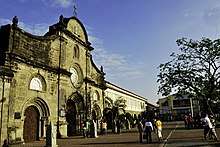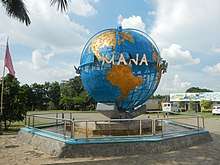Bulacan
Bulacan is a province in the Philippines. It is located just north of Metro Manila and shares boundaries with Pampanga and Nueva Ecija in the north, and Manila Bay on the south west.
Regions
The province is divided into three component cities and 21 municipalities (or towns).
Cities
- Angat - A frontier town known for its long river of the same name, which is famous for visiting and swimming. Angat Dam is the biggest dam in Bulacan.
- 🌍 Baliuag
- Balagtas - formerly known as Bigaa, it was renamed after its most famous resident, poet Francisco Baltazar (who assumed the name Francisco Balagtas), who wrote the classic epic Florante at Laura (Florante and Laura) while in prison.
- 🌍 Bocaue - well-known throughout the country as the Fireworks Capital of the Philippines, due to its numerous small businesses manufacturing and selling fireworks.
- Bustos
- Dona Remedios Trinidad - named after the mother of former first lady Imelda Marcos, DRT is the largest town in Bulacan, comprising a land area that is roughly one-third of the entire province.
- Marilao
- Malolos City - the seat of the provincial government. It was also the former national capital during the Revolutionary Period (in the waning years of the 19th century) and the site of many battles of the revolution.
- Meycauayan City - one of the oldest towns established not just in the province but also in the entire country. Its name translates to "[a place] with lots of bamboo", which can still be seen in the partly-rural northeastern barangays.
- Norzagaray- location of Ipo Dam.
- Obando - famed for its St. Clare festival, which features as well-known fertility folk dance parade.
- Pulilan - famed for its Carabao festival
- 🌍 San Jose del Monte City - a city made up of mostly-agrarian lands. San Jose del Monte was actually the province's first chartered city.
- San Rafael
- San Miguel
- Sta. Maria
Other destinations
Understand
Talk
Native Bulakenyos speak and write Tagalog. As a matter of fact, a good number of famous Filipino writers hail from Bulacan. Francisco Balagtas (after whom Balagtas town is named) was born here and wrote "Florante at Laura", which is deemed a classic in Philippine Literature and is a required reading in high schools. Jose Corazon de Jesus ("Huseng Batute") and the National Artist Virgilio Almario also hail from Bulacan. It is safe to regard the province as one of the seats of the Tagalog Language.
Nevertheless, a good number of Bulakenyos can understand and speak English, thanks to mandatory English education in the country. In particular, the younger generation of Bulakenyos have more exposure with the mass media and the Internet and, thus, with English.
Get in
The North Luzon Expressway (NLEX) is a major motorway that can get you into Bulacan from Metro Manila (particularly Quezon City and Valenzuela) and the neighbouring province of Pampanga. Exits in Bulacan include Marilao, Bocaue, Tabang, Sta. Rita and Pulilan. Comparatively and almost parallel to the NLEX, travellers can take the route of the McArthur Highway, stretching from the Bonifacio Monument in Caloocan City up to the Province of Pangasinan province in Northern Luzon.
Alternatively, passengers can travel to San Jose del Monte, Bulacan via Commonwealth Avenue and Fairview. City buses such as Mersan serve this area.
Get around
In the major highways, the main mode of transportation is through jeepneys.
There are also shuttle service/van service vehicles ("UV Express vans") that service longer routes within the province (for example, from Meycauayan to Malolos via the NLEX).
For the rest of the roads, you can get by tricycles.
See


- Barasoain Church (Malolos) - The site of the First Philippine Republic during the Revolutionary War. There is an adjoining museum at the parish convento.
- Biak na Bato National Park - The site of the Pact of Biak na Bato, an important truce forged by the Spanish government and the Revolutionary Philippine Government during the late 19th century
- Casa Real (Malolos) - a historical museum situated a few meters from the diocesan cathedral
- National Shrine of St. Anne (Hagonoy)
- National Shrine of the Divine Mercy (Marilao)
- Angat Waterpark (Angat)
- Pinagrealan Cave (Norzagaray)
- Puning Cave (Dona Remedios Trinidad)
- Amana Waterpark (Pandi)
Do
Eat
Native delicacies
- Ensaymada
- Inipit
- Pastillas, a favorite and popular "pasalubong" (or take home treat) in Bulacan. Traditionally, it is made of the best carabao's milk, but in commercial quantites, believed to be made out of locally produced and commercially available milk in supermarkets. Patiently simmerred in very low heat and painstakingly stirred into a soft and sticky batter that melts in your mouth, pastillas is rolled into finger-sized pieces, then rolled onto white sugar. Bulacan's pastillas are individually wrapped in white Japanese paper, as compared to the intricately cut pastillas wrappers as it is made in other parts of Luzon. They are then packed into colorfully patterned boxes, a practical way of handing these sweet delicacies either as gifts, or just as "pasalubong". Beware not to limit yourself to only a couple of boxes of these milky treats, as one may later on lament that he should have taken a half-dozen or a dozen even, boxes of the best pastillas of Bulacan.
- Puto, a rice cake that may be topped off with cheese slices or egg. Some of the most famed puto can be bought in Marilao and Mecauayan
- Suman
- Minasa
- Chicharon
Drink
Stay safe
Go next